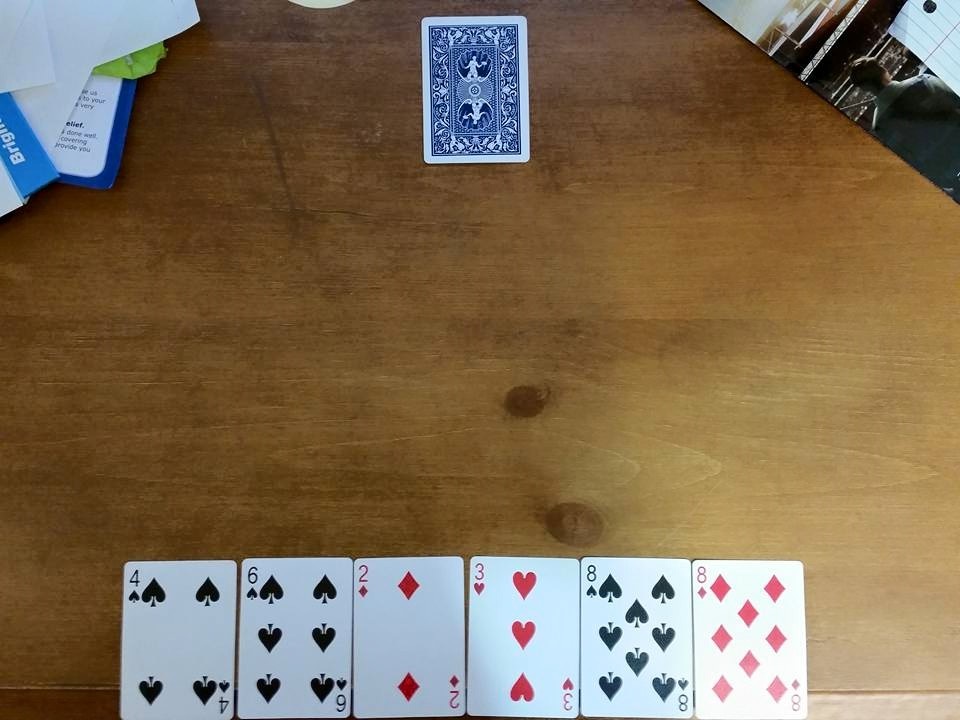Last March, on Pi Day (March 14, 2015), I put together a mathematical magic show for the Pi Day festivities at our local library, compiling various tricks that I teach to our future secondary teachers. I was expecting an audience of junior-high and high school students but ended up with an audience of elementary school students (and their parents). Still, I thought that this might be of general interest, and so I’ll present these tricks as well as the explanations for these tricks in this series. From start to finish, this mathematical magic show took me about 50-55 minutes to complete. None of the tricks in this routine are original to me; I learned each of these tricks from somebody else.

Though this wasn’t part of my Pi Day magic show, I recently read an interesting variant on my fourth trick. The next time I do a mathematical show, I’ll do this trick next — not to amaze and stun my audience, but to see if my audience can figure out why it works. Each member of the audience will need to have a calculator (a basic four-function calculator will suffice). Here’s the patter:
I want you to take out your calculator. Using only the digits 1 through 9, there are three rows, three columns, and two diagonals. I want you to pick either a row, a column, or a diagonal. Then I want you to enter a three digit number using those numbers. For example, if you chose the first row, you can enter 123 or 312 or 231 or any three-digit number using each digit once.

Now, I want you to multiply this number by another three-digit number. So hit the times button.
(pause)
Now, choose another row, column, or diagonal and type in another three-digit number, using each of the three digits once.
(pause)
Now hit the equals button to multiply those two numbers together.
(pause)
Is everyone done? The product you just computed should have either five or six digits. I want you to concentrate on one of those digits. Just make sure that you concentrate on a digit other than zero, because zero is boring. So concentrate on a nonzero digit.
(pause)
(I point to someone.) Without telling me the digit you chose, please tell me the other digits in your product.
The audience member will say something like, “3, 7, 9, and 2.” To which I’ll reply in three seconds or less, “The number you chose was 6.”
Then I’ll turn to someone else and ask which numbers were not scratched out. She’ll say something like, “1, 1, 9, 7, and 2.” I’ll answer, “The number you chose was 7.”
And then I’ll repeat this a few times, and everyone’s amazed that I knew the different numbers that were chosen.

Clearly this works using the same logic as my fourth magic trick: the product is always a multiple of 9, and so I can add the digits to figure out the missing digit. The more interesting question is: Why is the product always a multiple of 9?
This works because each of the factors of the product is a multiple of 3. Let’s take another look at the calculator.
 If the first row is chosen, the sum of the digits is 1+2+3 = 6, a multiple of 3. And it doesn’t matter if the number is 123 or 312 or 231… the order of the digits is unimportant.
If the first row is chosen, the sum of the digits is 1+2+3 = 6, a multiple of 3. And it doesn’t matter if the number is 123 or 312 or 231… the order of the digits is unimportant.
If the second row is chosen, the sum of the digits is 4+5+6 = 15, a multiple of 3.
If the third row is chosen, the sum of the digits is 7+8+9 = 24, a multiple of 3.
If the first column is chosen the sum of the digits is 1+4+7=12, a multiple of 3.
If the second column is chosen, the sum of the digits is 2+5+8 = 15, a multiple of 3.
If the third column is chosen, the sum of the digits is 3+6+9 = 18, a multiple of 3.
If one diagonal is chosen, the sum of the digits is 1+5+9 = 15, a multiple of 3.
If the other diagonal is chosen, the sum of the digits is 3+5+7 = 15, a multiple of 3.
This can be stated more succinctly using algebra. The digits in each row, column, and diagonal form an arithmetic sequence. For each row, the common difference is 1. For each column, the common difference is 3. And for a diagonal, the common difference is either 2 or 4. If I let  be the first term in the sequence and let
be the first term in the sequence and let  be the common difference, then the three digits are
be the common difference, then the three digits are  ,
,  , and
, and  , and their sum is
, and their sum is
 ,
,
which is a multiple of 3. (Indeed, the sum is 3 times the middle number.)

So each factor is a multiple of 3. That means the product has to be a multiple of  . In other words, if the first factor is
. In other words, if the first factor is  and the second factor is
and the second factor is  , where
, where  and
and  are integers, their product is equal to
are integers, their product is equal to
 ,
,
which is clearly a multiple of 9. Therefore, I can use the same adding-the-digits trick to identify the missing digit.
given
if
.









